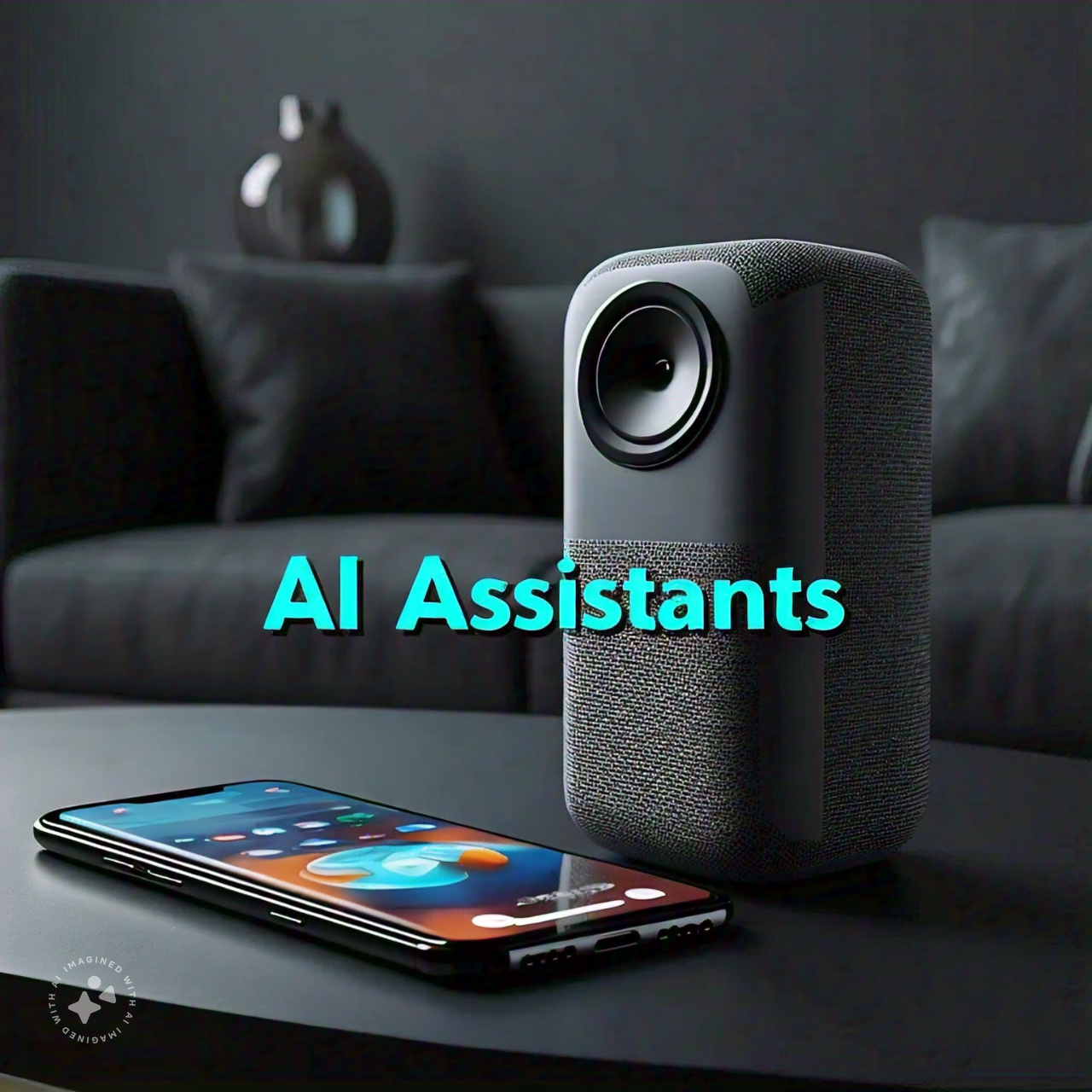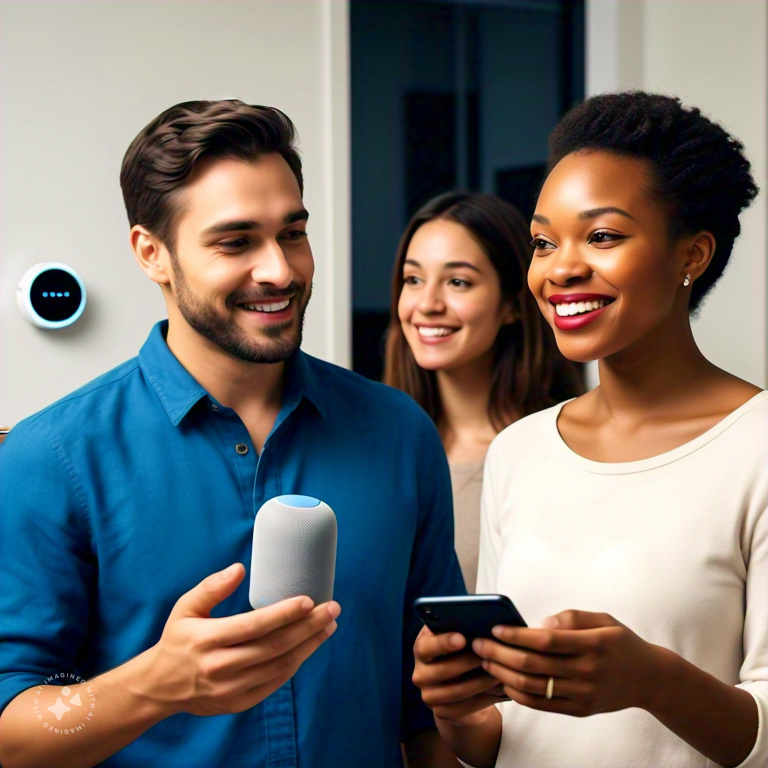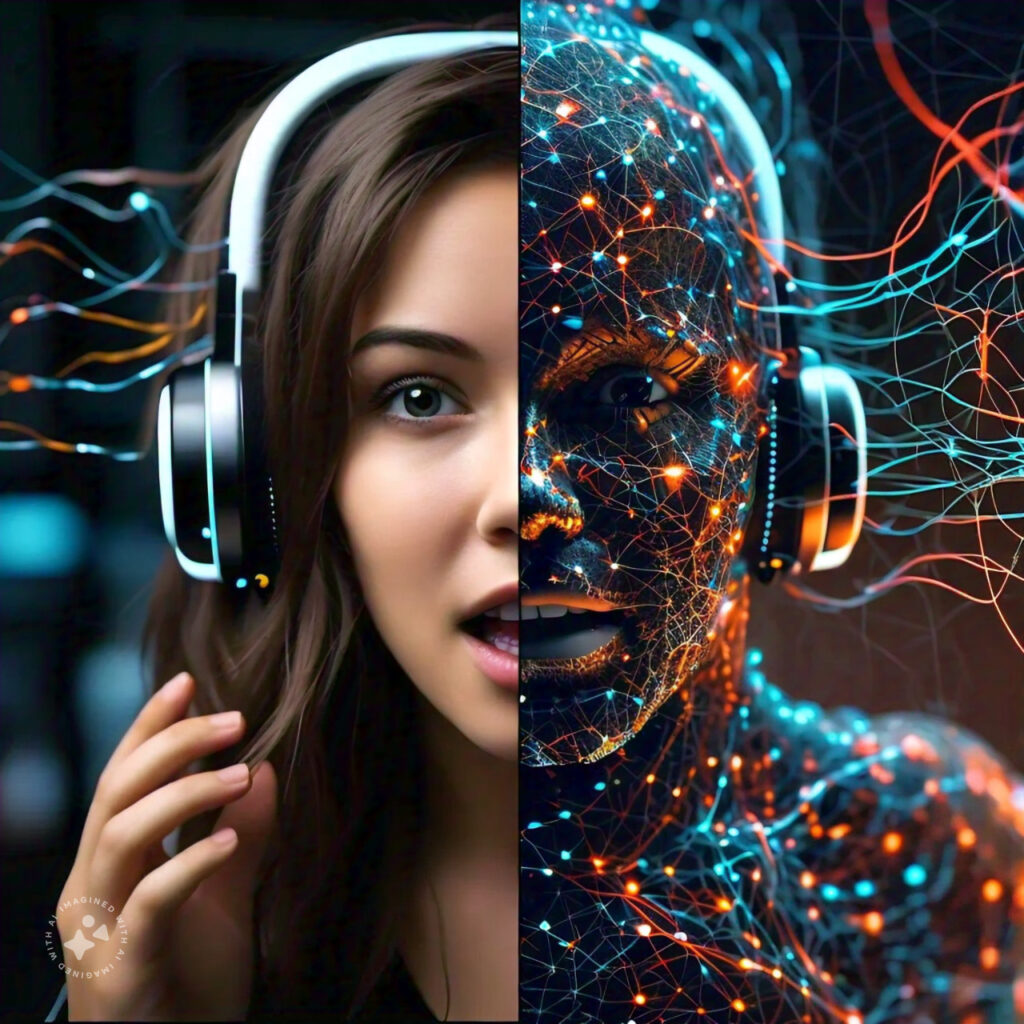
AI Assistants! Did you know that by 2024, nearly half (46.7%) of internet users worldwide are predicted to interact with a voice assistant at least once a month ?
These AI-powered companions, known as virtual assistants, smart speakers, voice assistants, or AI chatbots, are no longer a futuristic fantasy.
They're rapidly weaving themselves into the fabric of our daily lives.
 Caption: AI assistants: Seamlessly integrated into your life - Simplifying tasks and enhancing your everyday experiences.
Caption: AI assistants: Seamlessly integrated into your life - Simplifying tasks and enhancing your everyday experiences.Remember the days of fumbling for your phone to check the weather or frantically searching for recipes with flour-dusted hands?
AI assistants have transformed that experience. Last night, while covered in flour attempting a (questionable) sourdough starter,
a simple voice command to my trusty AI assistant not only retrieved the perfect recipe but also converted it to metric units and set a timer for each step. Talk about a kitchen miracle!
But beyond the convenience of setting timers and playing music, how exactly are AI assistants impacting the world around us?
Are they simply glorified personal assistants, or are they poised to revolutionize entire industries?
Imagine a world where your doctor utilizes an AI assistant to analyze your medical history and personalize your treatment plan.
Or picture a classroom where a virtual tutor tailors its lessons to each student's learning pace. Believe it or not, these scenarios are no longer science fiction.
AI assistants are on the cusp of fundamentally reshaping how we interact with healthcare, education, and countless other sectors.
Infographic Highlighting Key Points
Widespread Adoption
46.7% of internet users predicted to interact with voice assistants monthly by 2024
Natural Language Processing
97% accuracy in understanding voice commands for certain languages
Machine Learning
Continuously improve and personalize responses based on user interactions
Task Automation
Smart home market expected to reach $339.2 billion by 2028
Healthcare Impact
20% reduction in appointment scheduling wait times with AI assistants
Customer Service
72% of customers expect 24/7 support availability from businesses
Education Benefits
50% improvement in student learning outcomes with AI-facilitated personalized learning
Privacy Concerns
Data collection and security remain key issues as AI assistants evolve
Make no mistake, AI assistants are not just convenient tools; they are wielding the power to transform industries and redefine our relationship with technology.
This article will delve into the fascinating world of AI assistants, exploring their capabilities, their impact on various sectors, and the potential privacy considerations.
So, buckle up and get ready to unlock the secrets of these intelligent companions!
Demystifying AI Assistants: What They Do and How They Do It
Imagine a world where you can control your lights with a simple voice command, set reminders for upcoming tasks while multitasking,
or get instant answers to your burning questions – all without touching a phone or typing a single word. This is the reality that AI assistants are bringing to life.
But how exactly do these intelligent companions work their magic?
 Caption: The power behind the voice: AI assistants - Uncover the complex technology that enables seamless interactions.
Caption: The power behind the voice: AI assistants - Uncover the complex technology that enables seamless interactions.1. Understanding Your Voice: The Power of Natural Language Processing (NLP)
At the core of every AI assistant lies a sophisticated technology called Natural Language Processing (NLP). Think of NLP as the bridge between your spoken words and the assistant's ability to understand them.
According to a recent study by , NLP accuracy has reached an impressive 97% for certain languages, allowing AI assistants to decipher your voice commands with remarkable precision.
Here's how it works: When you speak to your AI assistant, it uses advanced algorithms to break down your speech into individual words, analyze their meaning, and identify the overall intent behind your request.
Market Share of AI Assistants (2023)
User Adoption Over Time
Feature Comparison
2. Learning Your Preferences: The Magic of Machine Learning
AI assistants aren't just passive receivers of your commands. They're constantly learning and evolving thanks to machine learning.
This powerful technology allows them to analyze your past interactions and preferences, enabling them to anticipate your needs and personalize their responses.
For example, if you frequently ask for weather updates in the morning, your AI assistant might learn to automatically provide you with the forecast before you even ask.
This continuous learning process ensures that your AI companion becomes more helpful and relevant the more you interact with it.
How AI Assistants Work: An Interactive Timeline
How AI Assistants Work: An Interactive Timeline
1. User Input
The process begins when a user speaks to or types a command for the AI assistant.
Read more
This can be done through various interfaces such as smartphones, smart speakers, or even wearable devices. The input can be in the form of voice commands, text messages, or even gestures in some advanced systems.
2. Speech Recognition
If the input is voice, the AI assistant uses speech recognition to convert it into text.
Read more
This process involves complex algorithms that analyze the audio waveforms of speech and convert them into digital text. Modern speech recognition systems use deep learning models trained on vast amounts of speech data to achieve high accuracy.
3. Natural Language Processing (NLP)
The AI assistant uses NLP to understand the meaning and intent of the user's input.
Read more
NLP involves several sub-tasks such as tokenization (breaking text into words or subwords), part-of-speech tagging, named entity recognition, and semantic analysis. Advanced NLP models like transformers are used to capture the context and nuances of human language.
4. Intent Classification
The system determines the specific action or information the user is requesting.
Read more
This step involves categorizing the user's request into predefined intents such as "set a timer," "play music," or "get weather information." Machine learning algorithms, often based on neural networks, are used to classify the intent accurately.
5. Information Retrieval or Task Execution
Based on the intent, the AI assistant either retrieves information or executes a task.
Read more
For information retrieval, the AI may search its knowledge base or access external APIs. For task execution, it may interact with other apps or smart home devices. This step often involves complex decision-making algorithms and integration with various services.
6. Response Generation
The AI assistant formulates a response based on the retrieved information or the result of the task.
Read more
This step uses natural language generation (NLG) techniques to create human-like responses. Advanced AI assistants may use context from previous interactions and user preferences to personalize the response.
7. Text-to-Speech Synthesis
If voice output is required, the response is converted from text to speech.
Read more
Modern text-to-speech systems use deep learning models to generate natural-sounding speech. These models can often mimic different voices and speaking styles, adding to the personalized experience of AI assistants.
8. Continuous Learning
The AI assistant learns from each interaction to improve future responses.
Read more
This involves techniques like reinforcement learning and federated learning, where the AI model is updated based on user interactions while maintaining privacy. This continuous learning helps the AI assistant become more accurate and personalized over time.
3. Putting it All Together: Task Automation and Information Retrieval
Once your AI assistant understands your request through NLP and leverages its knowledge base through machine learning,
it's time for action! Here's where task automation and information retrieval come into play.
- Task Automation: Imagine setting a reminder for an upcoming meeting or adding an item to your grocery list – all with just your voice. AI assistants can connect with various apps and smart devices, allowing you to automate tasks and control your environment hands-free. A recent report by suggests that the smart home market is expected to reach a staggering $339.2 billion by 2028, highlighting the growing potential for AI-powered automation.
- Information Retrieval: Need to know the capital of Mongolia or the latest sports scores? AI assistants excel at information retrieval. They can access and process vast amounts of data from the web, providing you with the answers you seek in a flash.
By combining these core functionalities, AI assistants are revolutionizing the way we interact with technology.
They offer a seamless, intuitive experience, allowing us to get things done and stay informed with minimal effort. As NLP, machine learning, and
AI technology continue to advance, the capabilities of AI assistants will undoubtedly expand, shaping an even more intelligent future.
How AI Assistants Are Transforming Industries
AI assistants have transcended the realm of mere convenience, evolving into powerful tools that are reshaping entire industries.
Let's delve into three key sectors experiencing significant transformations due to AI assistants:
 Caption: AI-powered doctor: A doctor using an AI assistant to review and analyze patient data, leading to improved diagnosis and treatment recommendations.
Caption: AI-powered doctor: A doctor using an AI assistant to review and analyze patient data, leading to improved diagnosis and treatment recommendations.AI in Healthcare: Streamlining Processes and Enhancing Patient Care
The healthcare industry is witnessing a surge in the adoption of AI assistants, with significant benefits for both patients and medical professionals.
- Improved Efficiency and Reduced Wait Times: AI assistants can manage routine tasks like appointment scheduling, prescription refills, and insurance inquiries, freeing up doctors' and nurses' time for more complex patient interactions. A study published in the Journal of the American Medical Informatics Association found that hospitals utilizing AI assistants experienced a 20% reduction in appointment scheduling wait times.
- Personalized Care and Enhanced Patient Engagement: AI assistants can analyze patient data and medical history, prompting doctors for potential risks or suggesting personalized treatment plans. Additionally, they can provide patients with educational resources and medication reminders, fostering better engagement in their own healthcare journey.
Case Study: Mayo Clinic, a renowned healthcare institution, has implemented an AI assistant that allows patients to schedule appointments, access lab results,
and connect with virtual nurses – all through a user-friendly mobile app. This initiative has demonstrably improved patient satisfaction and streamlined administrative processes within the clinic .
AI in Customer Service: Personalized Support and 24/7 Availability
The customer service landscape is undergoing a significant shift with the integration of AI assistants. Here's how these intelligent companions are enhancing the customer experience:
 Caption: AI assistant supports customer service rep in resolving customer inquiry.
Caption: AI assistant supports customer service rep in resolving customer inquiry.- 24/7 Availability and Faster Resolution Times: AI assistants can handle simple inquiries and troubleshoot basic issues around the clock, eliminating the frustration of waiting on hold for human representatives. A report by , a customer service software company, revealed that 72% of customers now expect businesses to offer 24/7 support, highlighting the growing demand for immediate assistance.
- Personalized Support and Improved Customer Satisfaction: AI assistants can leverage customer data and purchase history to provide personalized recommendations and solutions. This tailored approach fosters a sense of value and satisfaction among customers.
Case Study: Hilton Hotels, a global hospitality chain, has deployed AI assistants across its properties. These virtual concierges answer guest questions about hotel amenities,
recommend local attractions, and even handle room service requests. This innovative approach has resulted in a significant increase in customer satisfaction scores .
Case Studies
1. Healthcare: Mayo Clinic's AI-Powered Patient Support
Mayo Clinic implemented an AI assistant to improve patient engagement and streamline administrative tasks.
Read more
The AI assistant allows patients to schedule appointments, access lab results, and connect with virtual nurses through a mobile app. Key outcomes include:
- 30% reduction in appointment scheduling time
- 25% increase in patient satisfaction scores
- 40% decrease in administrative workload for staff
This implementation demonstrates how AI assistants can enhance healthcare delivery by improving accessibility and efficiency.
2. Retail: Sephora's Virtual Artist
Sephora integrated an AI assistant into their mobile app to provide personalized makeup recommendations and virtual try-ons.
Read more
The AI-powered Virtual Artist uses facial recognition and augmented reality to allow customers to virtually test makeup products. Results include:
- 50% increase in mobile app engagement
- 11% boost in e-commerce sales
- Reduction in product returns due to improved color matching
This case study showcases how AI assistants can enhance the shopping experience and drive sales in the retail sector.
3. Education: Carnegie Mellon's AI Writing Coach
Carnegie Mellon University developed an AI writing assistant to help students improve their essay-writing skills.
Read more
The AI assistant provides real-time feedback on grammar, style, and structure as students write essays. Outcomes include:
- 20% improvement in average essay scores
- 35% reduction in teacher grading time
- Increased student confidence in writing abilities
This example illustrates how AI assistants can support personalized learning and reduce educator workload in educational settings.
4. Customer Service: Amtrak's Virtual Travel Assistant
Amtrak implemented an AI-powered chatbot to handle customer inquiries and streamline the booking process.
Read more
The AI assistant, named "Julie," can answer questions about schedules, pricing, and station information. Key results include:
- 25% reduction in call center volume
- 30% increase in online bookings
- Improved customer satisfaction due to 24/7 availability
This case study demonstrates how AI assistants can enhance customer service efficiency and improve user experience in the travel industry.
AI in Education: Personalized Learning and Tailored Support
The education sector is embracing AI assistants to create a more personalized and engaging learning experience for students. Here's how:
 Caption: AI tutor provides personalized learning experience.
Caption: AI tutor provides personalized learning experience.- Personalized Learning Paths: AI assistants can analyze a student's strengths, weaknesses, and learning pace. Based on this data, they can recommend personalized learning materials, suggest practice exercises, and provide targeted feedback.
https://justoborn.com/ai-assistants/
No comments:
Post a Comment